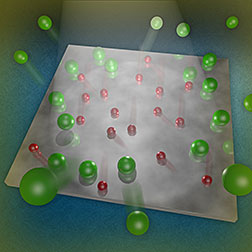- Number 411 |
- April 14, 2014
Krypton reporter uncovers oxygen’s antics

Krypton reporter uncovers oxygen’s antics.
Long thought to be unresponsive, oxygen adatoms, negatively charged oxygen ions stuck to a catalyst's surface, actually respond to ultraviolet light, according to scientists at DOE’s Pacific Northwest National Laboratory. The team made this discovery by coating the surface of common titanium dioxide with krypton reporters. When light strikes the metal oxide catalyst, the oxygen adatoms become electronically excited by reactions with electrons and/or holes created in the material by ultraviolet light. This excitation causes the adatoms to move and collide with -- and transfer energy to – the nearby krypton atoms, causing the atoms to depart.
"The adatoms could be an additional source of photochemical interactions on titanium dioxide or other transition metal surfaces," said Dr. Nikolay Petrik, a physical chemist at PNNL and one of two authors on the yearlong study. "Potentially, the adatoms could participate in other photochemical reactions."
Despite being part of numerous devices and industrial processes, photocatalytic reactions on metal oxides, such as titanium dioxide, are not well understood. This study answers basic questions about the behavior of oxygen adatoms and other forms of chemisorbed oxygen, where the oxygen is adsorbed onto the surface and held by chemical bonds. Fundamental knowledge could lead to innovations in catalysis and energy production technologies, such as solar and fuel cells.
"Oxygen on titanium dioxide is important because most applications involve oxygen in some way or another," said Dr. Greg Kimmel, a PNNL chemical physicist and the other scientist on the study.
To examine the oxygen's behavior, Petrik came up with the idea of adding reporter molecules to the surface and seeing what they would tell. Reporter molecules have been used for decades, but they had not been applied to this situation. Working together, Petrik and Kimmel began with a slightly reduced crystal of titanium dioxide. They absorbed different forms of chemisorbed oxygen, including oxygen adatoms and molecular oxygen, onto the crystals. Next, they added weakly bonding krypton and shined light on the surface. They found the krypton is knocked off the surface and can be easily measured.
Petrik offers this analogy for understanding the technique. Imagine a large room with an invisible person in it. How do you determine their location, their choices? You could fill the room with balloons. While you can't see the person move, you can determine their actions by the movement of the "reporter" balloons. Photo-active molecules, such as oxygen adatoms or molecular oxygen (O2), are like that invisible person. The departure of the krypton tells the scientists about how the oxygen prowls across the surface.
“To our knowledge, this is the first evidence for photo-activity of oxygen adatoms on rutile titanium dioxide,” said Petrik.
The U.S. Department of Energy, Office of Science, Office of Basic Energy Sciences, Chemical Sciences, Geosciences, and Biosciences Division sponsored this research.[Julie G. Wiley, 509.371.6968,
Julie.Wiley@pnnl.gov]
